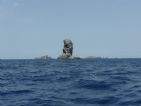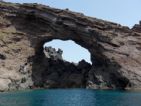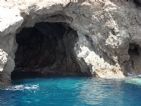
Day 2: Arrival at Columbretes
16/08/2010 18:44:52
Hi there!!
The same way as we experienced at the Eolian Islands, arriving is a very special moment. It is the time to compare not only data, but also all what we have been able to imagine when reading the book of the Archduke about the Columbretes Islands.
BOAT TOURS: Carallot, Foradada y Ferrera


The group of Carallot is formed also by seven other islets.


The view towards Carallot is beautiful. Some birds point already that we just arrived into a natural reserve.

When turning towards the east side, we can first see the islet Mendez Núñez and, in between this last one and Foradada, the islet Lobo.

We leave now Foradada and we sail towards la Ferrera.
First we run into the islet Navarrete which has its rocks pointing towards the west.

Just beside the south side of la Ferrera there is a very flat islet called Valdés.

HISTORY AND GEOLOGY: Columbretes
Xavi del Senyor and Eva Mestre, both part of the natural reserve technical team, give us some ideas concerning these two topics.
 Xavi tells us that the Columbretes Islands were already reported by the Ancient Greeks. We should see these islands as a meeting point, of people from Castellón, la Rápita or the Balearic Islands, where they just pass by for a while but do not stay. The place has always been dangerous and even more when navigation was just by sails or rowing.
Xavi tells us that the Columbretes Islands were already reported by the Ancient Greeks. We should see these islands as a meeting point, of people from Castellón, la Rápita or the Balearic Islands, where they just pass by for a while but do not stay. The place has always been dangerous and even more when navigation was just by sails or rowing.

The lighthouse keepers arrive with their families, and live and die in Columbrete Grande. Actually, that was one of the least appealing lighthouses in Spain. People had a very important impact on the island’s eco-system, and changed completely its appearance within a few years.
 Eva adds that a big change comes by the 80’s when the military pratice is forbidden and the Natural and Marine Reserves are created. Nowadays the initial appearance of the islands is in large part recovered.
Eva adds that a big change comes by the 80’s when the military pratice is forbidden and the Natural and Marine Reserves are created. Nowadays the initial appearance of the islands is in large part recovered.
The Columbretes are reported to be of a period of at least 300.000 years ago. The Columbrete Grande gets its present appearance as the sea erosion erodes the crater from its NE side.



Best wishes!








































